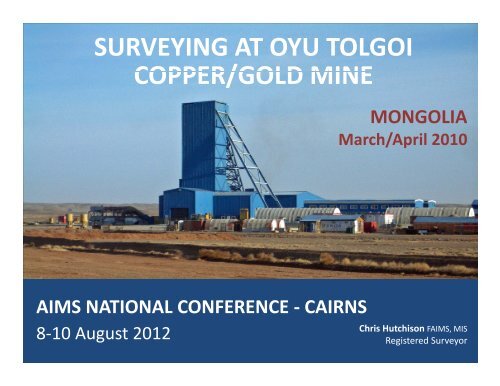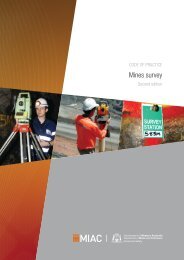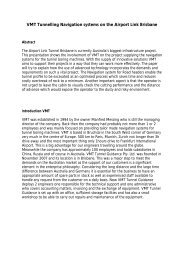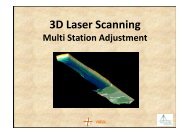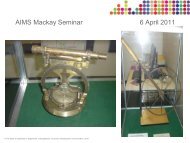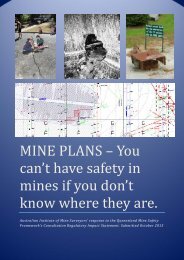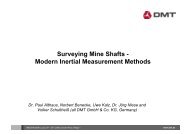Surveying at Oyu Tolgoi Copper/Gold Mine - Chris Hutchison - AIMS
Surveying at Oyu Tolgoi Copper/Gold Mine - Chris Hutchison - AIMS
Surveying at Oyu Tolgoi Copper/Gold Mine - Chris Hutchison - AIMS
Create successful ePaper yourself
Turn your PDF publications into a flip-book with our unique Google optimized e-Paper software.
SURVEYING AT OYU TOLGOI<br />
COPPER/GOLD MINE<br />
MONGOLIA<br />
March/April 2010<br />
<strong>AIMS</strong> NATIONAL CONFERENCE ‐ CAIRNS<br />
8‐10 August 2012<br />
<strong>Chris</strong> <strong>Hutchison</strong> F<strong>AIMS</strong>, MIS<br />
Registered Surveyor
OWNERSHIP & HISTORY<br />
• <strong>Copper</strong> has been recovered from this<br />
area since the bronze age as indic<strong>at</strong>ed<br />
d<br />
from the existence of small circular<br />
pits and minor copper smelting slag.<br />
• This site was discovered by Ivanhoe<br />
<strong>Mine</strong>s (a Canadian Company with<br />
worldwide interests) and verified by<br />
drilling over the last 10 years.<br />
• In October 2006, Ivanhoe <strong>Mine</strong>s and Rio Tinto signed a long term<br />
investment agreement with the Mongolian Government for the<br />
construction and oper<strong>at</strong>ion of the <strong>Oyu</strong> <strong>Tolgoi</strong> copper‐gold mining<br />
complex. In March 2010, the Mongolian Government announced<br />
th<strong>at</strong> conditions i precedent had hdbeen s<strong>at</strong>isfied ifidand th<strong>at</strong> the<br />
agreement now has full legal effect.
OWNERSHIP & HISTORY (cont)<br />
• The Investment Agreement cre<strong>at</strong>ed a Partnership:<br />
‐ Ivanhoe <strong>Mine</strong>s 66%<br />
‐ Mongolian Government 34%<br />
• Rio Tinto joined Ivanhoe <strong>Mine</strong>s as a str<strong>at</strong>egic 29.6%<br />
interest partner in the venture in 2006.<br />
• Based on drilling results, there are verified estim<strong>at</strong>es th<strong>at</strong><br />
the <strong>Oyu</strong> <strong>Tolgoi</strong> resource contains 81 billion pounds of<br />
copper and 46 million ounces of gold.
OWNERSHIP & HISTORY (cont)<br />
• Development is ahead of schedule for initial production<br />
to commence l<strong>at</strong>er this year with the start of commercial<br />
production in 2013.<br />
• A 100,000000 tonnes of ore per day copper concentr<strong>at</strong>or will<br />
process the initial open pit oper<strong>at</strong>ion.<br />
• This paper refers to survey work associ<strong>at</strong>ed with an<br />
85,000 tonnes per day underground block‐cave mining<br />
oper<strong>at</strong>ion being developed <strong>at</strong> the Hugo Dummet North<br />
Deposit with initial production in 2015. L<strong>at</strong>eral<br />
development on the 1300 metre level <strong>at</strong> Hugo North is<br />
ahead of schedule.
GEOLOGY<br />
The South Gobi area<br />
lies near the boundary<br />
of the South<br />
Mongolian and the<br />
South Gobi tectonic<br />
units.<br />
It has been<br />
increasingly arid since<br />
the l<strong>at</strong>e Cretaceous<br />
period and has been<br />
subject to continental<br />
uplift since the early<br />
Mesozoic period.
GEOLOGY (cont)<br />
The <strong>Oyu</strong> <strong>Tolgoi</strong> property, in general, has sparse outcrops comprising<br />
less than 20% of the area. <strong>Mine</strong>ralis<strong>at</strong>ion <strong>at</strong> the site is characterised<br />
by multiple copper gold porphyry centres which occur above and<br />
partially telescoped onto the underlying Cu‐Au porphyry systems.<br />
Hugo Dummet North is almost<br />
entirely within basalt.<br />
Molybdenite occurs locally in all<br />
rock types. <strong>Gold</strong> (ppm):<strong>Copper</strong><br />
(%) r<strong>at</strong>ios over much of the<br />
deposit are 110b 1:10 but, in strongly<br />
quartz‐veined intrusions, the<br />
r<strong>at</strong>ios increase to 1:1.
SITE CONDITIONS<br />
Temper<strong>at</strong>ure <strong>at</strong><br />
the mine varied<br />
from +10°C<br />
to ‐20°C during<br />
March 2010 while<br />
we were on site.
SITE CONDITIONS (cont)<br />
Accommod<strong>at</strong>ion <strong>at</strong> the site was in a camp and most of it is in “Girs”.<br />
These are the felt<br />
tent‐like houses used<br />
by the Mongolian<br />
nomadic people.<br />
We were<br />
accommod<strong>at</strong>ed in<br />
a twin room with<br />
shower/toilet<br />
facilities in the<br />
building similar to<br />
many Australian<br />
mine sites.
SITE CONDITIONS (cont)<br />
Transport to the mine from<br />
Ulaanba<strong>at</strong>ar was by a 90 se<strong>at</strong><br />
aircraft chartered by the<br />
mine which oper<strong>at</strong>es into and<br />
out of the mine four days per<br />
week.<br />
Heavy equipment is brought<br />
to the site by overland<br />
transport through the desert.<br />
There are no formed roads or<br />
railways between the mine<br />
and Ulaanba<strong>at</strong>ar.<br />
The mine site is only 90 km from the Chinese border and there are<br />
likely to be connections made to Chinese infrastructure.
SITE CONDITIONS (cont)<br />
The mine lies in the South Gobi Desert which is an extension of the Tibetan Pl<strong>at</strong>eau.<br />
The site is <strong>at</strong> 1280 metres above sea level.<br />
It is in UTM Zone 48<br />
and the site<br />
coordin<strong>at</strong>es are WGS84<br />
which makes them, in<br />
practical terms, the<br />
same as our MGA but<br />
in Zone 48.
SITE CONDITIONS (cont)<br />
Mongolia has a popul<strong>at</strong>ion<br />
of about 4 – 5 million.<br />
About 1 million live in the<br />
capital, Ulaanba<strong>at</strong>ar, there<br />
are another 4 or 5 regional<br />
cities and the remainder of<br />
the popul<strong>at</strong>ion live the<br />
nomadic rural life th<strong>at</strong> is<br />
centuries old.<br />
There are no rural fences. All appears to be “common” land where stock (horses,<br />
pp ( ,<br />
sheep, go<strong>at</strong>s and camels) are grazed. There must be farms of some sort as trucks<br />
bring vegetables into Ulaanb<strong>at</strong>aar daily but I didn’t see any farms.
PROJECT REQUIREMENTS<br />
AND PROJECT TEAM<br />
• Redp<strong>at</strong>h, a Canadian company, has been contracted to construct the shafts<br />
and underground development <strong>at</strong> the Hugo North mine.<br />
• C R <strong>Hutchison</strong> & Co Pty Ltd had provided<br />
gyro orient<strong>at</strong>ion services and technical<br />
support to CEH Dapto during the<br />
completion of a survey contract on the<br />
Big Gossan Project <strong>at</strong> the Freeport <strong>Mine</strong><br />
in Indonesia a few years ago for Redp<strong>at</strong>h.<br />
The success of th<strong>at</strong> project encouraged<br />
Redp<strong>at</strong>h to contact M<strong>at</strong>thew Smith of<br />
CEH Dapto in Wll Wollongong with a view to<br />
engaging him on a similar project in<br />
Mongolia. M<strong>at</strong>thew contacted C R<br />
<strong>Hutchison</strong> & Co with a request for gyro<br />
and specialised equipment support for<br />
the project.<br />
• The Australian team for this project<br />
was Team Leader M<strong>at</strong>thew Smith of<br />
CEH Dapto and <strong>Chris</strong> <strong>Hutchison</strong> (who<br />
couldn’t resist the opportunity).
PROJECT REQUIREMENTS<br />
AND PROJECT TEAM (cont)<br />
• The project required th<strong>at</strong> we:<br />
‐ Transfer survey<br />
control from the<br />
surface network to<br />
the shaft collar and<br />
the centre of a raise<br />
bore site which was<br />
proposed to be drilled<br />
from the surface to<br />
the 512 level;
PROJECT REQUIREMENTS<br />
AND PROJECT TEAM (cont)<br />
‐ Transfer survey control via the single existing shaft to the 512 level, establish<br />
orient<strong>at</strong>ion <strong>at</strong> th<strong>at</strong> level, traverse to the design loc<strong>at</strong>ion of the raise bore <strong>at</strong> th<strong>at</strong><br />
level and establish control there for a raise bore from 512 level to the 1300 level;<br />
‐ Transfer survey control via the<br />
shaft to the bottom of the mine<br />
<strong>at</strong> the 1300 level, establish<br />
orient<strong>at</strong>ion <strong>at</strong> th<strong>at</strong> level,<br />
traverse control to the raise<br />
bore chamber on th<strong>at</strong> level and<br />
extend survey control by gyro<br />
supported traverse throughout<br />
the 1300 level workings; and<br />
‐ Report the results of this work.
TECHNICAL SOLUTIONS<br />
• Due to the isol<strong>at</strong>ed area of the mine, it<br />
was decided dto use our GAK1 gyro<br />
<strong>at</strong>tachment to our T2 theodolite for gyro<br />
orient<strong>at</strong>ion work r<strong>at</strong>her than risk sending<br />
one of our Gyrom<strong>at</strong>s unaccompanied to<br />
Mongolia and back.<br />
The GAK1 was carried in hand luggage all<br />
the way to protect it. It did cre<strong>at</strong>e a lot<br />
of interest <strong>at</strong> customs X‐ray check points<br />
and a copy of its handbook was essential<br />
to convince security th<strong>at</strong> it was really a<br />
piece of surveying equipment.<br />
• Our TCRP1201 total st<strong>at</strong>ion was taken<br />
and, together with Leica precise prisms,<br />
used for traverse work on the surface<br />
and underground.
TECHNICAL SOLUTIONS (cont)<br />
• Laser plumbing equipment, umbrellas (also caused some interest in<br />
customs), the trusty HP41CV calcul<strong>at</strong>or, diagonal eye pieces (for<br />
sighting shaft plumbing piano wires), laptop computers and other<br />
small items were all taken as passenger’s luggage (which included a lot<br />
of cold we<strong>at</strong>her gear, some from Antarctic days) and made the<br />
combined luggage of the team 100 kg overweight from the Air China<br />
point of view.<br />
It made me very thankful th<strong>at</strong> M<strong>at</strong>thew Smith is a very fit and strong<br />
It made me very thankful th<strong>at</strong> M<strong>at</strong>thew Smith is a very fit and strong<br />
young man when it came to moving this gear through security for<br />
various air transport movements.
TECHNICAL SOLUTIONS (cont)<br />
• A German team had been <strong>at</strong> <strong>Oyu</strong> <strong>Tolgoi</strong> in 2007 to transfer control down<br />
the #1 shaft <strong>at</strong> Hugo North. They used a DMT Gyrom<strong>at</strong> (early model) to<br />
establish orient<strong>at</strong>ion and some 8 wall st<strong>at</strong>ions <strong>at</strong> the 1300 level with 3D<br />
coordin<strong>at</strong>es.<br />
They plumbed the shaft using optical plumbing from the surface with<br />
verific<strong>at</strong>ion by measurement of horizontal and vertical angles and slope<br />
distances from the foot of the shaft to st<strong>at</strong>ions <strong>at</strong> the shaft collar using a<br />
high precision total st<strong>at</strong>ion.<br />
However, due to the temper<strong>at</strong>ure gradient in the shaft of about 40<br />
degrees Celsius, the effects of refraction reduced the precision of the<br />
plumbing so th<strong>at</strong> the German group reported th<strong>at</strong> the accuracy of their<br />
results was not better than plus or minus 100 mm. Our hope was to<br />
achieve a tighter coordin<strong>at</strong>e solution as it was a requirement th<strong>at</strong> the<br />
two raise bores became a single vertical shaft from the surface to the<br />
1300 level.
TECHNICAL SOLUTIONS (cont)<br />
• As the mine is rel<strong>at</strong>ively new, we enquired by email if any of the piano<br />
wires used to sink the shaft still existed and we were told th<strong>at</strong> three of<br />
the original six remained.<br />
The team resolved to go back to the “tried and true” old fashioned<br />
method of plumbing the shaft using those wires. They were thoroughly<br />
checked to ensure they were not fouled on any part of the shaft<br />
concrete and all the steady brackets were fully opened to ensure the<br />
wires followed gravity without a bend.<br />
Prior to commencement, 100 pound weights were <strong>at</strong>tached to each<br />
wire and each weight was damped in a 44 gallon drum filled with oil.<br />
The ventil<strong>at</strong>ion was shut down for 12 hours before measurement so<br />
th<strong>at</strong> the wires could steady.
TECHNICAL SOLUTIONS (cont)<br />
• R<strong>at</strong>her than observe Weisbach triangles <strong>at</strong><br />
the 512 and 1300 levels from the wires into<br />
each drive, it was decided to “radi<strong>at</strong>e” each<br />
of the three wires using the gyro orient<strong>at</strong>ion<br />
bearing so th<strong>at</strong> there were three<br />
independent coordin<strong>at</strong>es available for the<br />
initial st<strong>at</strong>ion <strong>at</strong> each level.<br />
The wires were carefully observed a<br />
number of times <strong>at</strong> each level (using the<br />
diagonal eye piece <strong>at</strong> 1300 level because of<br />
cage infrastructure) and we were surprised<br />
to find them very stable with ihno long period<br />
oscill<strong>at</strong>ion discerned. Distances to the wires<br />
were measured reflectorless with a backing<br />
sheet held behind the wire to assist where<br />
possible.
TECHNICAL SOLUTIONS (cont)<br />
• Gyro orient<strong>at</strong>ions were measured <strong>at</strong> the shaft <strong>at</strong> 512 and 1300 levels as<br />
well as <strong>at</strong> the raise bore chamber (512 level) and <strong>at</strong> the furthest inbye<br />
traverse leg (1300 level).<br />
At the surface, a comparison<br />
gyro orient<strong>at</strong>ion was<br />
measured between two<br />
survey control pillars (which<br />
provided a rot<strong>at</strong>ion for the<br />
other orient<strong>at</strong>ions) and<br />
another gyro orient<strong>at</strong>ion was<br />
measured on a baseline<br />
straddling the surface raise<br />
bore position to “close” the<br />
surface traverse angles <strong>at</strong><br />
th<strong>at</strong> site.
TECHNICAL SOLUTIONS (cont)<br />
• Connections were made from the<br />
surface traverse to the #1 shaft<br />
subcollar area and <strong>at</strong> th<strong>at</strong> level to the<br />
top of the three piano wires to<br />
determine their coordin<strong>at</strong>es which<br />
were transferred to the lower levels.<br />
• The underground traversing was<br />
completed using the TCRP1201<br />
and precise prisms using “sets of<br />
angles” software.
CONCLUSION<br />
• The coordin<strong>at</strong>e transfer from the surface to the 512 level by three wires showed<br />
a standard devi<strong>at</strong>ion of plus or minus 5 mm, a surprisingly good result.<br />
The coordin<strong>at</strong>e<br />
transferred from the<br />
surface to the 1300 level<br />
by three wires showed a<br />
standard devi<strong>at</strong>ion of<br />
plus or minus 10 mm, an<br />
equally surprisingly good<br />
result.
CONCLUSION (cont)<br />
• Our GAK1 gyro was calibr<strong>at</strong>ed <strong>at</strong> Newcastle University baseline<br />
just prior to departure for Mongolia.<br />
The comparison between our GAK1 and the d<strong>at</strong>um line of<br />
orient<strong>at</strong>ion adopted for the project (baseline joining OT13 and<br />
OT11 surface pillars) was GAK1 plus 31.6 arc seconds equals<br />
d<strong>at</strong>um. This rot<strong>at</strong>ion of +31.6 arc seconds was applied to all<br />
other gyro orient<strong>at</strong>ions to maintain their rel<strong>at</strong>ivity to the surface<br />
d<strong>at</strong>um line.<br />
At the surface raise bore baseline, the initial gyro comparison<br />
showed th<strong>at</strong> the coordin<strong>at</strong>e join by the mine coordin<strong>at</strong>es differed<br />
by 36 arc seconds (higher) h than the gyro bearing.<br />
At the 512 level, the mine coordin<strong>at</strong>e join <strong>at</strong> the shaft differed by<br />
7 minutes 36 seconds (higher) than the gyro bearing and 2<br />
minutes 44 seconds (higher) than the gyro bearing <strong>at</strong> the raise<br />
bore chamber.
CONCLUSION (cont)<br />
At the 1300 level, the mine coordin<strong>at</strong>e join near the shaft differed by 6 seconds<br />
(higher) than the gyro bearing. This shows a good comparison between the German<br />
gyro controlled coordin<strong>at</strong>es of the wall st<strong>at</strong>ions <strong>at</strong> th<strong>at</strong> level.<br />
The angular misclose in our traverse <strong>at</strong> 1300 level compared to the initial gyro showed<br />
only 11 arc seconds and, <strong>at</strong> the 512 level, the difference between the gyro<br />
orient<strong>at</strong>ions was 4 arc seconds. After adjustment of our traverse for the angular<br />
miscloses revealed by the gyro orient<strong>at</strong>ions and using the coordin<strong>at</strong>es we transferred<br />
to the surface and into the mine, the new coordin<strong>at</strong>e joins differed from the gyro<br />
bearing as follows:<br />
‐ Surface calibr<strong>at</strong>ion baseline coordin<strong>at</strong>e grid ±0.0 seconds to gyro (d<strong>at</strong>um line)<br />
‐ Surface raise bore baseline coordin<strong>at</strong>e grid ‐0.2 seconds equals gyro<br />
‐ 512 level (shaft) coordin<strong>at</strong>e grid +1.4 arc seconds equals gyro<br />
‐ 512 level (raise bore) coordin<strong>at</strong>e grid +1.0 arc seconds equals gyro<br />
‐ 1300 level (shaft) coordin<strong>at</strong>e grid ‐0.7arc seconds equals gyro<br />
‐ 1300 level (inbye traverse end) coordin<strong>at</strong>e grid +0.3 arc seconds equals gyro
CONCLUSION (cont)<br />
The raise bore positions <strong>at</strong> surface, 512 level and 1300 level are affected by the<br />
combined projection and height scale factors <strong>at</strong> their levels. The projection scale<br />
factor is a constant but, because of the mine loc<strong>at</strong>ion in the zone and the l<strong>at</strong>itude of<br />
the mine, the height scale factor varied by about 200 mm per kilometre between the<br />
surface and the 1300 level.<br />
This fact is further complic<strong>at</strong>ed by the local <strong>Mine</strong> Surveyors not using either a<br />
projection or height scale factor in their traverses and the principal’s requirements<br />
th<strong>at</strong> we provide plane rectangular (mine grid) coordin<strong>at</strong>es for survey st<strong>at</strong>ions<br />
(including the raise bore sites) <strong>at</strong> each level.<br />
This led to there being a different local coordin<strong>at</strong>e <strong>at</strong> each mine level for the raise<br />
bore site to maintain a truly vertical shaft hftowards the centre of the earth.
CONCLUSION (cont)<br />
There were, as a result, some time<br />
consuming calcul<strong>at</strong>ions (and check<br />
calcul<strong>at</strong>ions) to finally provide the<br />
requested coordin<strong>at</strong>es.<br />
However, we were very pleased to<br />
have the principle of our work<br />
proven in August 2010 when we<br />
received an email from Mongolia<br />
advising th<strong>at</strong> the drill hole from<br />
the surface to the 512 level broke<br />
through “spot on” our prediction.<br />
As we have not received any further inform<strong>at</strong>ion it is believed they<br />
are still working on the 512 to 1300 level and we are hoping for a<br />
similar result.
Acknowledgements<br />
• Thanks are due to M<strong>at</strong>thew Smith and CEH Dapto for<br />
giving me the opportunity to take part in this interesting<br />
project.<br />
• Thanks are also due to Paul Beveridge, the new owner<br />
of C R <strong>Hutchison</strong> & Co Pty Ltd, for his positive <strong>at</strong>titude<br />
to the project and his trust th<strong>at</strong> the special surveying<br />
equipment would be returned to Australia safe and<br />
sound.<br />
• Thanks to Nigel Atkinson, Nicholas Baillieu and the<br />
committee organising this conference for the<br />
opportunity to talk about this project.<br />
<strong>Chris</strong> <strong>Hutchison</strong> F<strong>AIMS</strong>, MIS<br />
Registered Surveyor
Questions?


